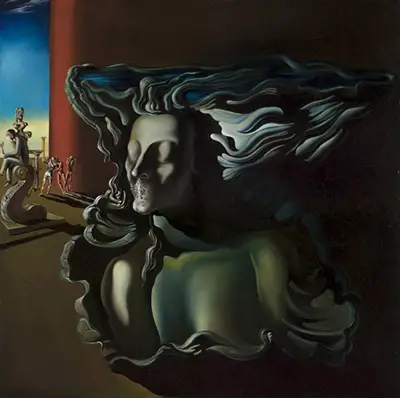In The Dream, the woman's hair is floating all around her, as though underwater, or captured in the midst of movement. Her eyes and mouth appear as though they have been sealed shut. Ants, which were for Dali symbolic of death and decay, crawl over the mouth.
This sensory depravation and apparent loss of control seem to signify the paralysis and sensory confusion often experienced during sleep in the dream state.
Behind the woman, we see more symbolic imagery. To the left, a man with an amputated foot holds his bloodied face in his hands. From his back, a column emerges with the face of a bearded man.
These figures allude to the Myth of Oedipus and the suppression of the man's fantasies. Behind this man, we can see two male figures embracing while a third man leans against the red background, almost as if trying to pass through to the other side.
Salvador Dali was an eccentric and fascinating artist whose legacy continues to influence the painters, writers, and film makers of today.
Perhaps no other artist is more synonymous with the 20th century art movement known as Surrealism more than the Spanish painter Salvador Dali.
Dali and his fellow surrealists believed the state between wakefulness and sleep was the place where our greatest creative potential exists. The Surrealist movement sought to destroy convention and unleash the artistic potential residing within the unconscious.
Throughout his life, Dali produced over 1,500 paintings depicting bizarre, dream-like images, heavy with symbolism. In addition to this, he also created sculptures, jewellery, and worked extensively in the world of film and theatre.

